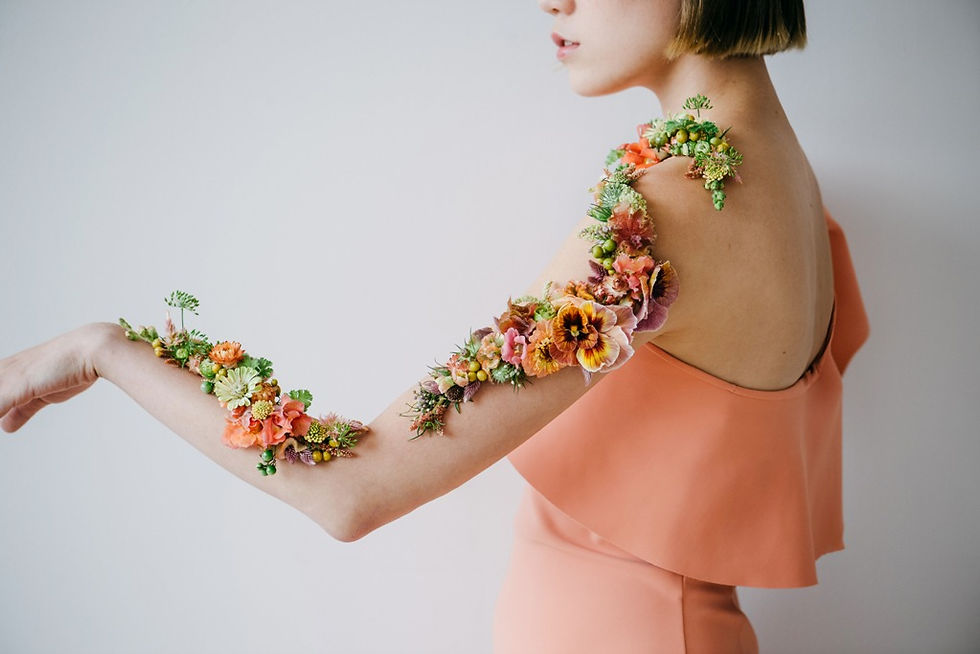Q&A with our Keynote Presenter Susan McLeary
- E. T. Perry
- Apr 5, 2020
- 4 min read

Susan McLeary (c) Amanda Dumouchelle
"I might see a fashion show, for instance, and think—wow, that collar on that jacket is just amazing, I wonder how that would look made out of carnation petals."
As a designer, artist, educator, and author, Susan McLeary, this year’s Slow Flowers Summit keynote speaker, stretches her floral wingspan, producing a feast for the eyes in her designs. In addition to arrangements, bouquets, and centerpieces—more typical fare when it comes to floristry—Susan also combines flowers to create jewelry, installations, clothing, and more. Whether she is working on “a tiny little floral ring or a huge floral installation,” her process relies on working in layers—heaviest and darkest to lightest and most airy—to create interest, movement, and depth. With wearables, one of the signature elements of her design work, Susan likes to spur curiosity. “What’s interesting to me now is choosing materials that, when combined, don’t at first glance say ‘flower.’”

A floral tattoo from The Art of Wearable Flowers
For local, seasonal materials, Susan turns to her own backyard, the local farmer’s market, and the local flower grower’s co-op in her community. She finds that local flowers are “more expressive—they have more bends and curves and natural qualities that are attractive to a designer.” She also feels that forming relationships with growers and knowing what it takes to produce sustainable flowers gives value to floristry as an art form and makes the medium “more rich.” She emphasizes flowers’ emotive nature, highlighting the personal connections we form with different flowers: “Growing up in the Midwest, all the family gardens had marigolds, so when I design with marigolds, I’m having this delicious memory of the scent and the sunny summer days…. Somebody else might remember a trip to India and think—that was such an amazing experience and these marigolds are bringing all of that emotion back.”

Statement necklace from The Art of Wearable Flowers
Having done client-focused design work for many years, Susan has now transitioned to mostly teaching, and her desire to educate aspiring designers stems from her own experience. “When I found this new art form that I wanted to investigate, it was difficult for me to find instruction,” she says. “I took a certification through a local organization and then took a six-week class at a community college as well,” but both were pretty traditional and focused mostly on “the standard shapes and mechanics of floristry.” As a result, “I kind of got a little bee in my bonnet about offering other options; that became something really important and interesting to me—to gather as much information as I could and then share it with people.” Susan’s desire to broaden designers’ minds to what’s possible with flowers is authentic: “I just really don’t like the idea of people thinking floristry is a very simple, limited art form. I want people to know there’s so much richness, and there are so many ways to go about things; if you start investigating, you’ll never run out of ideas to experiment with.”

Susan McLeary designs with Amaranth, two ways: Floral fringe (left) and Natural hair (right)
Susan’s keynote address for the 2020 Slow Flowers Summit, “The Creative Journey: Finding Your Artistic Voice, Truth, and Expression,” focuses on the wealth of possibilities in floristry and how to nurture your creative instinct as a designer and artist. “I really think that florists have been put in a box in a way. Floral design is a service, of course, but I think a lot of [designers] are trained to react instead of guide the creative process,” she describes. “I’m really trying to push the idea forward that we are artists”—a concept which need not mean anything boastful. “It was hard even for me to call myself an artist a few years ago, because it just felt so self-indulgent,” she says. Letting go of that feeling, however, was part of realizing that the more designers focus on what excites them, “the more we can push this art form forward.”

More lovely wearable florals
Finding her own voice drives Susan to inspire others: “I’m really interested in promoting floral design as an art form and boosting florists, adding my voice to the floral world by boosting the craftsmanship of floristry.” Her first book, The Art of Wearable Flowers, released in March 2020, also has this message at its heart. She says that in addition to florists, the book is meant “for the public, for anyone who might have a vague interest in fashion or garden design or just a flower enthusiast.” This is because “I think my role is twofold: My role is to inspire florists to make what they’re interested in making and [to] grasp and lead with the art form, but also I think it’s really fun to surprise the public…. They’re not in our little floral bubble and they don’t see all the things that we can do,” all the ways designers have “to really capture the imagination.”
Note: All images (c) Amanda Dumouchelle
Amanda Dumouchelle is an international, published award-winning photographer based in Michigan. Her work has been published in multiple wedding, lifestyle, and floral design magazines and books. Her work reflects emotion, sophistication, and simplicity.
A book-signing will follow Susan's presentation at the Slow Flowers Summit
Slow Flowers welcomes our 2020 Summit contributor E. T. Perry. E. T. is a writer and editor based in New England. She graduated with honors from Vassar College in 2013, earning her BA in English and specializing in literature and literary theory. She is a lover of sustainable agriculture and self-reliance, and has experience gardening and farming, including on a flower farm in the Hudson Valley, NY. She has contributed creative writing, arts journalism, and literary criticism to a variety of publications, both in print and online.










































Comments